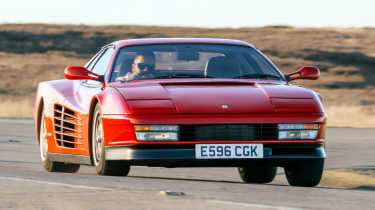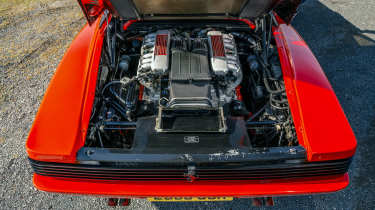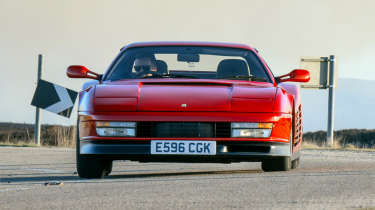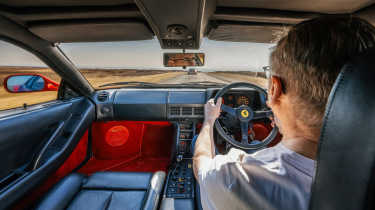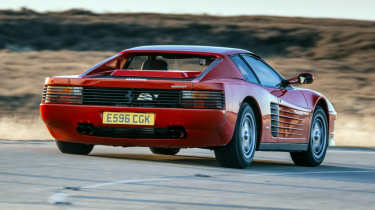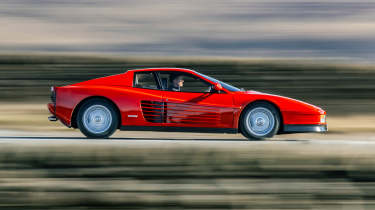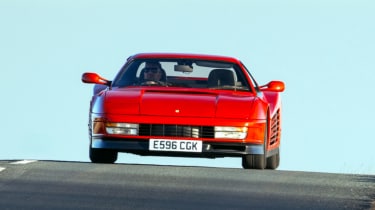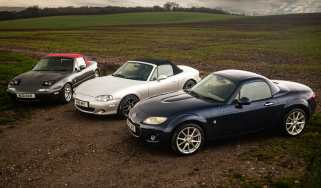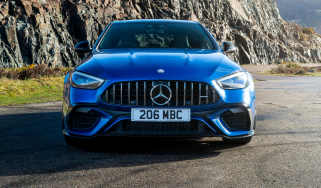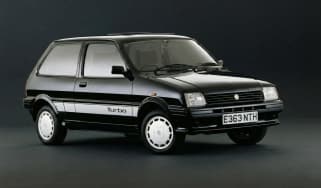Ferrari Testarossa (1984 - 1991) review – the Lamborghini Countach’s more usable arch enemy
The Testarossa is famed for being the more accessible ‘80s supercar than the Countach it rivalled but was no less of a pinup icon
Nothing summed up the hedonistic more-is-more spirit of the ’80s better than the Ferrari Testarossa, a car that did not feature in the pages of evo until issue 185 in 2013. The ‘redhead’ was named for the crimson cam covers of the Testarossa’s engine, a thoroughly reworked version of the Berlinetta Boxer’s flat-12.
Making its debut at the 1984 Paris show, what Ferrari called ‘the world’s most powerful and most luxurious Gran Turismo car’ would serve in the brand’s lineup for 12 years in various forms.
In 1991 Testraossa became 512 TR, then in 1994 512 TR became 512M, before the all-new 550 Maranello took over in 1996 to begin a long-serving dynasty of front-mid-engined V12 Ferrari grand tourers that continues today with the 12 Cilindri.
History and specs
The original Testarossa is the icon, though. Peak power was 385bhp courtesy of a 4.9-litre flat-12 engine putting power to the rear wheels via a five-speed transmission. It's not a boxer as the cylinders don't actually have individual crankpins – it’s actually a 180-degree V. It was also mounted quite high atop the transmission and differential. The chassis was of a tubular steel design with double unequal-length wishbones, coil springs and telescopic dampers. The steering was unassisted.
More reviews
Performance wasn't much by today’s supercar standards, with 0-62mph coming up in 5.8sec, on the way to a top speed of 181mph. The finned flanks were born of necessity because several markets wouldn’t allow the large apertures needed to feed the rearwards-relocated radiators, but they became a TR signature and a key component of its exotic other-worldliness. evo’s predecessor Performance Car loved it. ‘As a blender of outright speed and cruising comfort, roadholding and responsiveness, dynamics and driveability, the Testarossa is as good as they come.’
> Ferrari F80 2025 review – near-1200bhp tech tour de force tested on road and track
The black grille spread across the whole frontal expanse of the car certainly accentuates the huge breadth, and at 1976mm the Testarossa is wider than any current Ferrari. Other angles don't look quite as good; the single mirror is very cool, but also looks very odd at times, and the single intake (servicing an oil cooler) underneath the headlight on the same side only accentuates the imbalance.
In profile you notice the almost disproportionately huge front overhang, but in motion, particularly slicing past the jagged rock and lush grass of country hillsides, it remains every bit as jaw-droppingly dramatic as it did in the '80s.
Interior
The first thing that strikes you is how much room there is inside the Testarossa. Open the door and there seems to be a lot of stuff between you and the seat, with two silver releases and the handbrake to clamber across. With its elongated headrest, the seat is comfy and surprisingly supportive.
The black leather-covered dashboard set right back against the bottom of the windscreen, makes the cabin feel remarkably airy and the visibility is extremely good too.
Although there's much more room than in a Countach, the actual driving position is similarly awkward, with the pedals well spaced but offset to the right on this left-hand-drive car and the top of the steering wheel tilted tantalisingly away from you. The beautiful lever for the dog-leg five-speed gearbox is a pleasure, though, the black ball (slightly smaller than a golfball) nestling perfectly into your palm.
Driving the Ferrari Testarossa – Peter Tomalin, evo eras: 1980s, issue 334
“Harry Metcalfe loves his TR; he’s famously driven it to Africa, and when this shoot is over he’s embarking on a tour of the Scottish Highlands. Just like any car, it’s all the better for getting regular exercise, though earlier on this mid-March morning Harry took the first stint from cold (and it was cold, all the cars being covered with frost). Despite the flat-12 being fuel-injected it is, he says, a bit grumpy first thing (I know the feeling). He talks me through deactivating the immobiliser – a common feature on several of these cars and a reminder that car crime was a major ballache back then.
“This is not a car you jump into and howl off down the road. The seats are set well into the cabin, which is pleasingly spacey with a low scuttle. The driving position’s not as idiosyncratic as in some classic supercars, though the steering wheel (a beautifully simple Momo, shared with the Ferrari F40) is still canted a touch away from you and the pedals markedly offset to the left as the inner wheelarch steals foot-space.
“The controls are heavy – the gearshift especially so, its stiff action requiring concentration and a firm, deliberate hand, especially coming back down the ’box – and there’s a little kickback through the steering over bumps, while in bright sunlight the top of the dash reflects in the screen at certain angles. So it takes acclimatisation. But gradually you relax into the TR and begin to explore a little more of the throttle’s long travel: so long that, as in a ’90s TVR, it acts as a rudimentary form of traction control.
“Harry advised cracking the window open at some point, the better to hear the flat-12, and once I’ve lowered it, down it stays for my whole time with the car. Because, as others have noted, the single most glorious, memorable thing about the TR is the sound of its engine. There’s all this wonderful ’80s excess all around you – the view in the door mirrors over those sculptural flanks is just fabulous – and yet the howling soundtrack shouts late-’60s or early 1970s Formula 1 Ferrari, not entirely surprising when you remember the origins of the roadgoing flat-12.
“It’s physical, but not wearing. A sports car with GT civility and a naturally relaxed, long-striding gait. You never forget its width, but you don’t get the same sensation of sitting at the pointy end of a rocket with an enormous body behind you, as you would in, say, a Diablo. Push on and in tighter turns you can feel a hint of understeer, clearly telegraphed, to let you know you’re getting close to the limits of the relatively modest Michelins.
“There’s decent brake response and feel – a rarity in this group. Just as well in someone else’s 40-year-old 180mph-plus flat-12 Ferrari. As I manoeuvre it back into its slot at the muster point with all eyes on the TR, I stall it. Twice.
> BMW M3 (E30, 1986-1990) review – the greatest M car of all?
“James Taylor took his turn in the TR earlier: ‘I had the Matchbox toy as a boy so I’m very grateful to Harry for letting me experience it. I love that you have all the drama and theatre of a supercar but with a long-legged GT feel. You’re conscious of all the weight behind you but it never gets unruly.’ Dickie’s been pushing it harder than most of us: ‘It’s physically quite hard work,’ he reports, ‘but it flows quite well and it leans and there’s some give in the tyres, so it’s quite a wide zone where it’s starting to work, quite an elastic limit.’
“We all love the engine: ‘Completely different to a modern 12-cylinder Ferrari,’ says Yousuf. ‘Very old-school, really flexible.’ And then there’s the sheer visual drama, of course. Barker can remember the impact that the Testarossa made with its avant-garde, none-more-’80s styling. ‘Launched in a nightclub,’ he recalls. Naturally…”
Driving the Ferrari Testarossa – Henry Catchpole, evo 185 (2013)
“The star of the show is undoubtedly the engine: it's magnificent. It's so tractable, with a deep well of thrust that builds and builds down a long straight, piling on speed in the most wonderful crescendo to 6500rpm. The engine is also what defines the Testarossa in the corners. The little 16-inch wheels with their 50-profile sidewalls play their part, but it's the first time you feel the weight of those 12 cylinders start to swing a little and affect the balance behind you that sticks in the mind.
”The trouble is that the longitudinal, Colombo flat-12 is mounted on top of the gearbox and diff, which as you can imagine makes for a centre of gravity akin to a hippo on a bird table. So the best thing to do on the road is relax, not push too hard and just enjoy the theatre of the Testarossa. Then it feels like one of the best places in the world to be.
”Sitting at traffic lights the lumpy ba-dum ba-dum ba-dum idle sounds for all the world like a CanAm car that has just been fired up in the paddock at Goodwood. Then I make the mistake of putting the window down as we go through a tunnel. With the car being a left-hooker, I'm sitting so close to the tunnel wall that I get the full force of the decibels as they reverberate around the concrete cavern. Quite honestly, it's painful. I've heard some loud cars in my time, but no road car gets close to the physicality of an unsilenced Testarossa. The resonances it triggers deep inside my left ear feel like there is a tuning fork in my head about to explode.
”I can't remember the last time I inched up so cautiously towards the limits of a car, gradually pushing the tyres and chassis a little further each time round. Initially, there's more push at the front than I was expecting, and more grip from the wide tracks of each axle, but then I notice I'm pouring the car into the corners and squeezing on the power so as not to unsettle it.
”As speeds increase, it's those long, faster corners that are the most nerve-wracking. Load up the front, then get on the power early and drive through the corner with the car transitioning from subtle understeer to very subtle oversteer on the exit as the weight behind you pushes round. The steering feels heavier now that there's more load going through the wheels, and although there's some feel, it's still remarkably vague thanks to the combination of those tall sidewalls and a huge amount of roll.
> Audi Quattro (1980-1991) review – a 1980s road-going rally icon
”The brakes are not built for track work, so you need to slow the 1506kg Testarossa early and gently if you want to do more than a handful of laps, but as braking hard and deep into the corners is a sure-fire way to unsettle it, that's perhaps no bad thing. Thankfully Llandow is flatter than the Testarossa's engine, because what the Ferrari would be like heading through a corner with adverse camber or a crest is not something I'd like to find out in a hurry.
”If you carry too much speed into a corner and need to lift even here then you have to be right on top of the car, because that high, rearward centre of gravity will swing round with an inexorable momentum as you pitch the weight onto the already loaded outside rear wheel. There are two things that make it just about manageable, the first being that the engine is naturally aspirated, so the power delivery is beautifully linear and workable. The second is the amount of steering lock available.
”When the momentum does take over and the huge rear deck rolls into oversteer behind your shoulders, you need to work that thin-rimmed steering wheel very fast indeed, not only adding the corrective lock to catch it but then anticipating when to start taking the lock off again as the car regains grip and the momentum rolls back the other way. Get it right and it feels heroic and perhaps heart-stopping in equal measures there's a reason why you didn't see many shots of oversteering Testarossas back in the day.
”After one day driving it, I feel like a bigger fan of the Testarossa than I ever was as a child (it was always the 288 GTO for me) and part of me is trying to work out where it'd fit into my dream garage. I can see why it did so well in America, which isn't the insult some might think. It's not trying to be part-track weapon, part-continent crusher like an F12, because although it was absorbing trying to tame it on the circuit, it is first and foremost a road car for long journeys and big roads. Its handling might well be intimidating, but it certainly deserves its place in evo.”
Specs
| Engine | Flat-12, 4943cc |
|---|---|
| Power | 385bhp @ 6300rpm |
| Torque | 361lb ft @ 4500rpm |
| Weight | 1708kg (229bhp/ton) |
| Tyres as tested | Michelin Pilot Sport |
| 0-60mph | 5.8sec |
| Top speed | 181mph |
| Basic price | £62,666 (1984) |
| In today's money | £200,068 |
